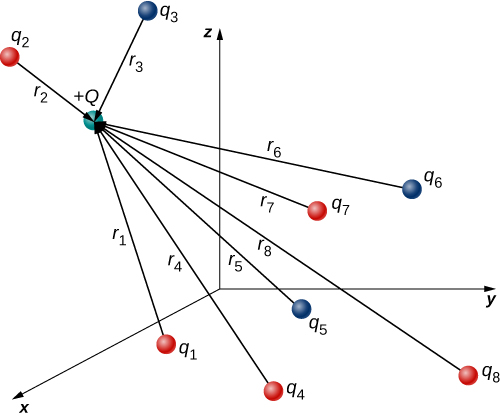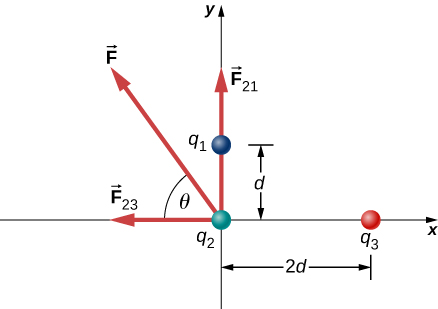| << Chapter < Page | Chapter >> Page > |
In this expression, Q represents the charge of the particle that is experiencing the electric force , and is located at from the origin; the are the N source charges, and the vectors are the displacements from the position of the i th charge to the position of Q . Each of the N unit vectors points directly from its associated source charge toward the test charge. All of this is depicted in [link] . Please note that there is no physical difference between Q and ; the difference in labels is merely to allow clear discussion, with Q being the charge we are determining the force on.

(Note that the force vector does not necessarily point in the same direction as the unit vector ; it may point in the opposite direction, . The signs of the source charge and test charge determine the direction of the force on the test charge.)
There is a complication, however. Just as the source charges each exert a force on the test charge, so too (by Newton’s third law) does the test charge exert an equal and opposite force on each of the source charges. As a consequence, each source charge would change position. However, by [link] , the force on the test charge is a function of position; thus, as the positions of the source charges change, the net force on the test charge necessarily changes, which changes the force, which again changes the positions. Thus, the entire mathematical analysis quickly becomes intractable. Later, we will learn techniques for handling this situation, but for now, we make the simplifying assumption that the source charges are fixed in place somehow, so that their positions are constant in time. (The test charge is allowed to move.) With this restriction in place, the analysis of charges is known as electrostatics , where “statics” refers to the constant (that is, static) positions of the source charges and the force is referred to as an electrostatic force .


Notification Switch
Would you like to follow the 'University physics volume 2' conversation and receive update notifications?